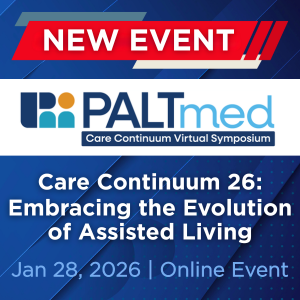Who We Are
Post-Acute and Long-Term Care Medical Association (PALTmed) is the only medical specialty society representing the community of medical directors, physicians, nurse practitioners, physician assistants, and other practitioners working in the various post-acute and long-term care (PALTC) settings. The Society’s members work in skilled nursing facilities, long-term care and assisted living communities, CCRCs, home care, hospice, PACE programs, and other settings.
PALmed runs a certification program for medical directors in PALTC, credentialing Certified Medical Directors (CMDs).
The Foundation for Post-Acute and Long-Term Care Medicine (an affiliate organization of PALTmed) oversees awards, community outreach, education, and research with the mission to advance the quality of life for persons in PALTC through inspiring, educating, and recognizing future and current health care professionals.
Vision
Empowered clinicians providing optimal health care excellence in the long-term care continuum.
Mission
PALTmed leads the way in empowering compassionate and skilled clinicians to deliver person-centered care in the post-acute, and long-term care continuum.
History of PALTmed
The American Medical Directors Association (AMDA), was officially chartered in June, 1977, when Dr. James Pattee (as the AMA's representative) and Mr. Herman Gruber (of the AMA Aging Committee staff) went to Hilton Head, South Carolina, to swear in Dr. William Dodd as founding president of the organization.
Dr. Dodd, a family practitioner based in Macon, Georgia, recognized the need to organize and educate physicians who would fulfill the role of the physician medical director created by federal mandate in 1975.
The association stayed in Georgia until 1988, when it moved to the Washington, DC area, where it could better influence the momentous changes in nursing home reform ushered in by the passage of OBRA '87. Indeed, AMDA commented on virtually every regulation stemming from the OBRA '87 legislation. This increased activity in national public policy began a period of membership building that attracted younger primary-care physicians who were becoming increasingly involved in long-term care.
Building on this early history, the association has grown to become a recognized source of expertise on clinical practice and physician leadership in PALTC. The Society's Clinical Practice Guidelines (CPGs), for example, are referenced in the CMS State Operations Manual, and AMDA’s 22 evidence-based CPGs are considered the standard processes of care in the nursing home setting.
In 2014, the Society House of Delegates voted to change the organization’s name to AMDA – The Society for Post-Acute and Long-Term Care Medicine. This was done (a) to better reflect how the PALTC field has expanded to include all settings across PALTC from skilled nursing to home care and hospice; (b) to recognize that, while the Society's historical focus has been on nursing home medical direction, the society has always represented the full interprofessional practice team in PALTC, including attending physicians, nurse practitioners, physician assistants, and others. Along with the name change, the House voted to expand general (i.e., voting) membership to include nurse practitioners and physician assistants.
In 2024, the House of Delegates voted unanimously to change the organization’s name to the Post-Acute and Long-Term Care Medical Association (PALTmed). “This name is inclusive and representative of all clinicians working in PALTC and truly reflects who we are, what we do, and what we stand for,” says Board President Rajeev Kumar, MD, FACP, CMD. “Our mission and vision for the organization have evolved over time, and more than ever, we care for patients and residents in a very competent and compassionate way through a multi-disciplinary team approach. We have become much more diverse and inclusive.”'
The name change is the first step in an extensive rebranding and membership expansion campaign to transform the organization into THE association for all clinicians practicing in PALTC. PALTmed will continually evolve to meet the needs of members and empower them to serve their patients and residents. The name change, too, is part of an evolution. In 2014, the organization changed its name from the American Medical Directors Association to AMDA – The Society for Post-Acute and Long-Term Care Medicine. “We kept the AMDA moniker because it was familiar to many people and was still part of our identity,” says Dr. Kumar.
Value Statements
- We are dedicated above all to quality in PALTC processes and outcomes.
- We strive to deliver person-centered and goal-concordant care in all PALTC settings of care.
- We are tireless advocates in all venues.
- We are committed to being an authoritative information resource on PALTC.
- We value and promote diversity, equity, and inclusion.
- We are a community – connected to and supportive of each other.
History of CMD Certification
The Certified Medical Director (CMD) Certification Program was established in 1991 by the Post-Acute and Long-Term Care Medical Association (PALTmed), formerly known as the American Medical Directors Association. Its creation followed three years of extensive research and development, involving surveys, consensus conferences, and expert input to define the core skills and knowledge essential for effective medical direction in post-acute and long-term care settings.
Previously managed by the American Board of Post-Acute and Long-Term Care Medicine (ABPLM), the CMD Certification Program transitioned to PALTmed on January 1, 2025, following the dissolution of ABPLM. The CMD Certification continues to recognize medical directors’ expertise in clinical and leadership roles. Certification is granted based on evidence of clinical and management education and experience, evaluated through a comprehensive application process.



